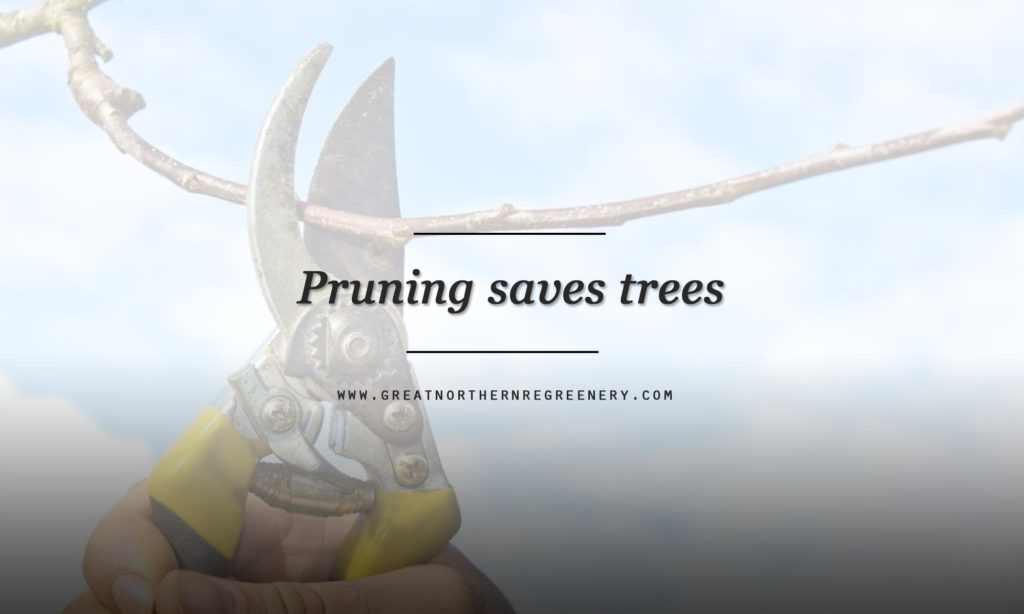
Winter falls hard in northern climates. Ice storms, huge amounts of snow, and brutal winds are part of the season and can be very hard on both humans and trees. Before winter hits, get your trees ready to survive the harsh winter season and flourish come spring.
Getting your trees ready for the winter will take some time (and perhaps some financial investment), but the end result will be absolutely worth it. The tips outlined below will help you understand what your trees need and what you can do yourself — or with the help of a trusted professional tree service.
Examine Your Trees
It’s best before you start to have a complete picture of your trees’ health. This will require the help of an arborist who will inspect your trees and provide a report and recommendations. The arborist can tell you which trees might require additional support for the winter, or if any ones may have to be removed. They can also provide further advice on how to prep your canopy for the winter months.

Prune
Once you have a clear picture of the state of your trees, it’s time to start pruning them. Pruning prevents damage from snow load and wind, and ensures vigorous growth when warmer weather arrives. Using clean, sharp tools, start by cutting off the suckers (the spindly little branches that grow out around the base of the tree), any dead or weak branches, and then take out some height. Be sure to prune right to the trunk and use sharp, clean tools. Although lower branches can be handled by some novices, having a professional tree service do this job ensures that your trees remain healthy and you don’t injure yourself.
Water
Believe it or not, trees need water for the winter. Yes, they’re dormant, but before the ground freezes, they’ll need to be watered well; snow melt can’t do much if the ground is frozen. With deciduous trees (leafy ones), wait until all the leaves have dropped and then water the surrounding area around the base until just before the ground freezes. If you water in the early fall, the tree keeps producing new growth — which could be vulnerable if an early frost or snow storm hits. Coniferous trees don’t become fully dormant (they don’t drop their needles). These can be watered any time right up until the ground freezes.
Wrap
Put a little winter blanket on your trees. Wrapping your trees is a prudent way to prevent damage from ice, salt, and critters (like deer and mice). Wrap the trunk of deciduous trees — especially young ones — and put a burlap wrapping around coniferous trees like cedars.
Brace
Larger, mature trees might also require some cabling or bracing to prevent damage to trees, property and avoid injury to people or pets. This is not a DIY job. A tree service will need to be brought in to secure the larger branches, offering protection from falling limbs and extending the life of your beautiful older trees.
Mulch

The freeze/thaw cycle can wreak havoc on root systems, causing the nearby soil to expand and contract, exposing roots or heaving saplings out of the ground. Mulching can prevent this by maintaining a more even temperature around the base of the tree, insulating roots, and retaining moisture. Apply 5 to 8 centimeters (2-3 inches) of mulch around the base of the tree, but not too close to the trunk – think more “donut” than “volcano shape.”
Build Barriers
Creating barriers around your trees is also an effective way to deter critters. Using a ¼ inch mesh wire, place it like a fence around the base of your tree and bury it a few inches down in the soil to prevent burrowing animals from getting at your young trees.

Some further things to consider this winter as your trees are slumbering in preparation for the spring:
- If you need to use de-icer near your trees, try to use a product that contains sodium chloride. Rock salt interferes with a tree’s ability to absorb nutrients, oxygen, and moisture. Use products that contain potassium, magnesium chloride, or calcium instead.
- After a substantial snowfall, you’ll want to venture outside and brush heavy snow from the branches of your tree (particularly young ones). If freezing rain were to add to this heavy snow, it could be disastrous for your trees.
- If there is ice buildup (and chances are there will be) don’t break it off the branches of your trees. Take a hose or pots of water and melt it off gently.
Additional Care after Damage
Should your trees sustain winter damage, they’ll need to be pruned and assessed to see how much damage has been done and what further steps may be required. To prune winter damaged trees, use the three-cut method:
- Make a cut from the underside up, about 1/3 way around, but not through the branch. This is used to prevent the branch from splitting away, tearing off bark and exposing the tree to the elements.
- The second cut is a couple of inches above the first cut, and this takes the branch off.
- Cut the stem back to the trunk, just above the branch collar.
If the tree has only been lightly damaged, you can use a sling or a wire to support the limb. And remember, if the main stems haven’t been affected, no pruning will be required. Remember that taking good care of your trees and preparing them properly for the winter can save you this aggravation in the first place.
Once you’ve removed the damaged branches, you may be able to see whether the tree is worth saving (although this may be more evident in the spring). If you’re unsure how to do any of this work, call in tree experts to help. They can do the proper check, determine where damage has occurred, and establish if a needs to be removed. They can also remove an unsightly stump — which is also a hazard for tripping and injury.

At Great Northern ReGreenery, we help with all your tree needs, including tree removal, cabling and bracing, tree inspection, and all the other services needed to keep your trees in tip top shape this winter. We serve Alliston, Barrie, Bradford, Newmarket, and Aurora areas. Call us at (905) 775-7444 for quality work and excellent service; we also provide a free inspection and assessment.





